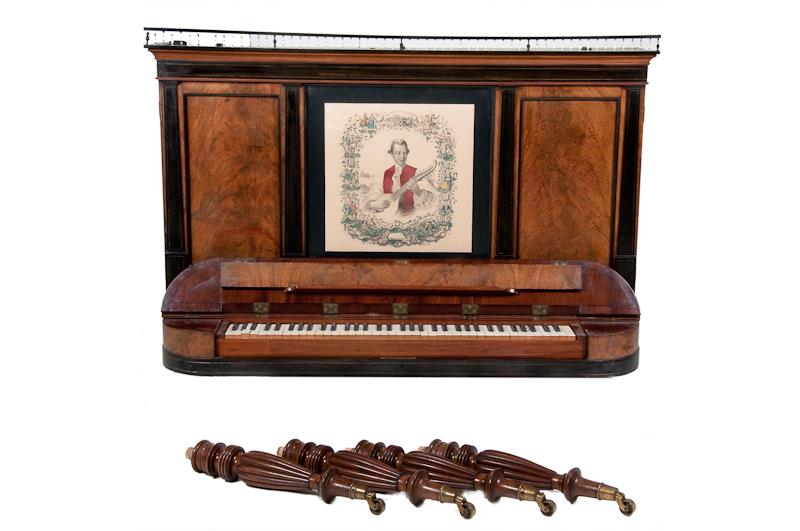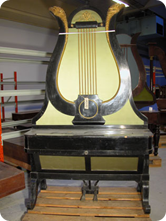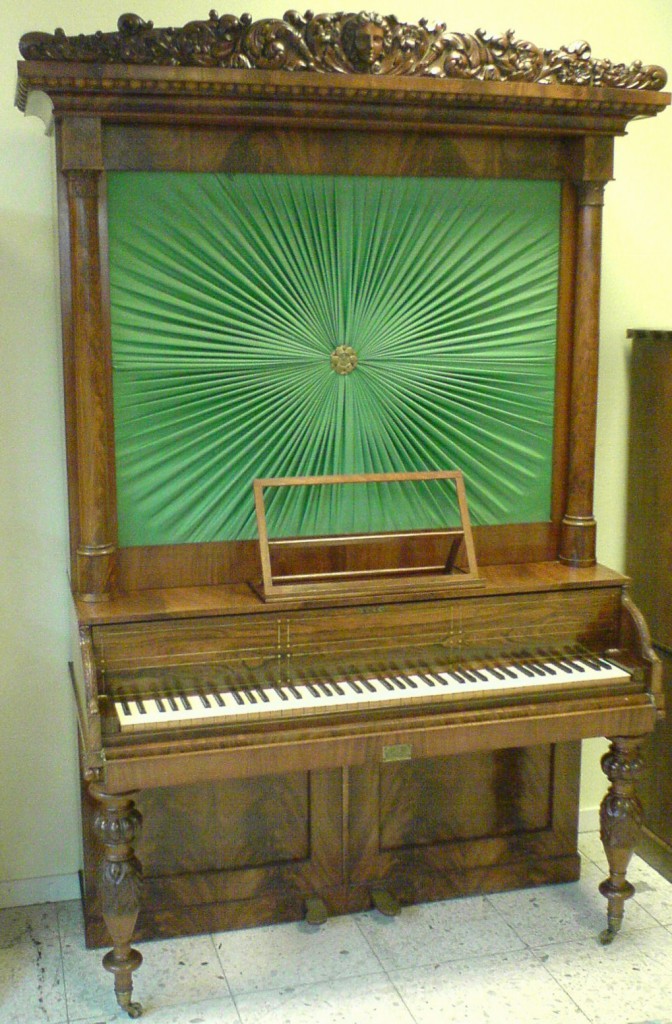The instrument we often think of when we use the term “piano” are in fact the youngest of the hammered instruments. Upright pianos (also known as pianinos) originated in Germany in the middle of the 18th century, and developed into their modern form during the 19th century. They come in many varieties, which are determined by the height of the mechanism, or more accurately the string lengths. Common to all of them is that they have vertical strings/soundboard and a mechanism that works horizontally against the strings. In Sweden we call them “upprättstående” (upright-standing) instruments, a term taken over from the English “upright”. The most common forms are presented here.
In the earliest period, a series of models emerged that deviate from our idea of what an upright piano should look like. These are quite tall instruments with varying external shapes.
The pyramid piano, shaped like a pyramid with a truncated, flat top, was internationally popular until about 1825 (and in Sweden until somewhat later). The oldest, so-called “pantalons”, appeared around 1740 and had a simple mechanism without dampers. Such were made in Stockholm during the 1750s by Lars Kinström, organist, piano builder and amateur organ builder. In Sweden, the term “pantalon” seems to have been used slightly differently to elsewhere on the continent, and specifically refers to such upright instruments. (See also Helenius, Eva, “Svenskt instrumentmakeri 1720-1800: En preliminär översikt” STM 1977:1) Wilhelm Bothe’s masterpiece-drawing from 1820 shows a typical 19th-century pyramid piano. Bothe was active in Stockholm until about 1840 and built, among other things, such instruments. An amateur builder who may have been inspired by Bothe’s instrument was Lars Olof Norell, vicar of Enånger.
The giraffe-grand piano, which has the shape of a standing grand piano with a rounded shell or scroll at the top of the tail, originated in the very last years of the 18th century and was manufactured until the middle of the 19th century. They were available as both single and double. The double “giraffes” have a mirrored frame, which is connected to the instrument itself and only contains shelves for sheet music. A Swedish piano maker who made such “giraffes” was Carl Jacob Nordqvist in Stockholm, active 1816-1828.

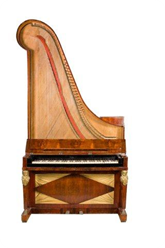
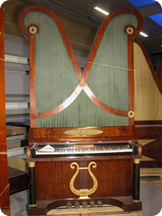
The lyre grand piano is, as the name suggests, shaped like a classical lyre. It is said to have been invented around 1824 by an instrument maker in Berlin named Johann Christian Schleip. The model was not so common but was exhibited as late as at the first International exhibition in London in 1851. There are no known Swedish piano makers who made lyre grands.
England came to be one of the leaders in the development of hammered instruments. Among the oldest English upright models from the very last years of the 18th century is a grand piano which, from its horizontal form, was raised vertically against the wall, where shelves for sheet music etc. were placed in the spaces free from the strings. Mechanics and wiring are hidden by two doors (wardrobe).
This so-called cabinet piano was invented in 1807 by William Southwell in Dublin. It is a rather tall creation (approx. 2 m), where the strings run parallel to the sides (straight strung). The upper frame is often covered with a single-colored pleated fabric, which hides the mechanics without hindering good sound dispersion, and whilst being an eye-catching and decorative feature. The instrument was common until the middle of the 19th century, when it had to give way to shorter forms of upright instruments. It was quite common in Sweden, where it was manufactured by Olof Granfeldt, Pehr Rosenwall, Jonas Sundell and others. in Stockholm and has also been made by factories in Gothenburg, e.g. Johan Heinrich Daug (coated 1820-1846) and J.G. Malmsjö (1850s).
Pianinos are, as the name suggests, a smaller upright instrument. It was this type that developed into what we call the upright piano. The first evidence for such instrument is English builders Robert Wornum’s “harmonic piano” from 1811, and the name and model were quickly adopted by other piano builders. Over the century, the piano was developed by leading piano makers in England, France, Germany and the USA. After about 1870, it finds its “modern” forms with cross stringing, cast iron frame and double repeating mechanism. An English piano was imported to Sweden as early as 1814 and may have been made by Wornum himself. However, it would take until the 1840s, before the piano won more general entry into the production of Swedish piano makers, and until about 1870, before it began to displace its main competitor, the table.
